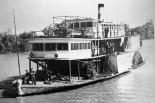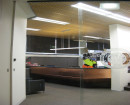Back to search results
PADDLE STEAMER GEM
SWAN HILL PIONEER SETTLEMENT, MONASH DRIVE SWAN HILL, SWAN HILL RURAL CITY
PADDLE STEAMER GEM
SWAN HILL PIONEER SETTLEMENT, MONASH DRIVE SWAN HILL, SWAN HILL RURAL CITY
All information on this page is maintained by Heritage Victoria.
Click below for their website and contact details.
Victorian Heritage Register
-
Add to tour
You must log in to do that.
-
Share
-
Shortlist place
You must log in to do that.
- Download report
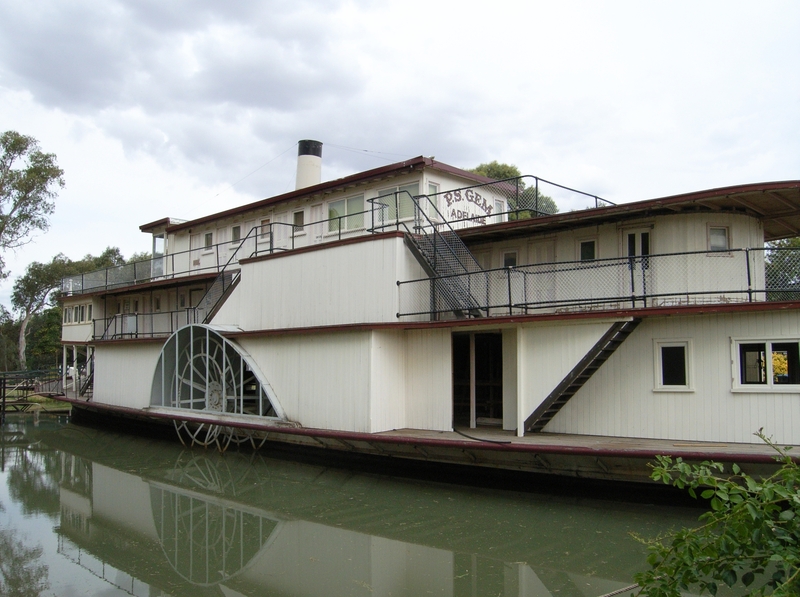
PADDLE STEAMER GEM SOHE 2008

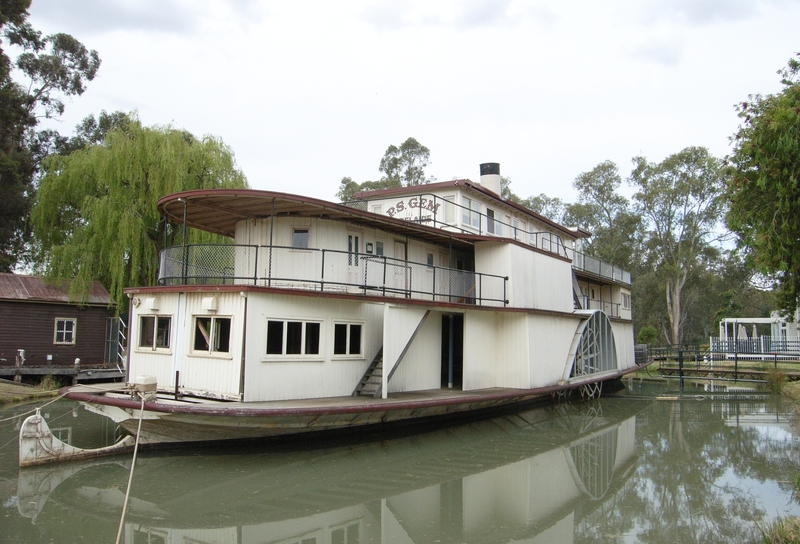
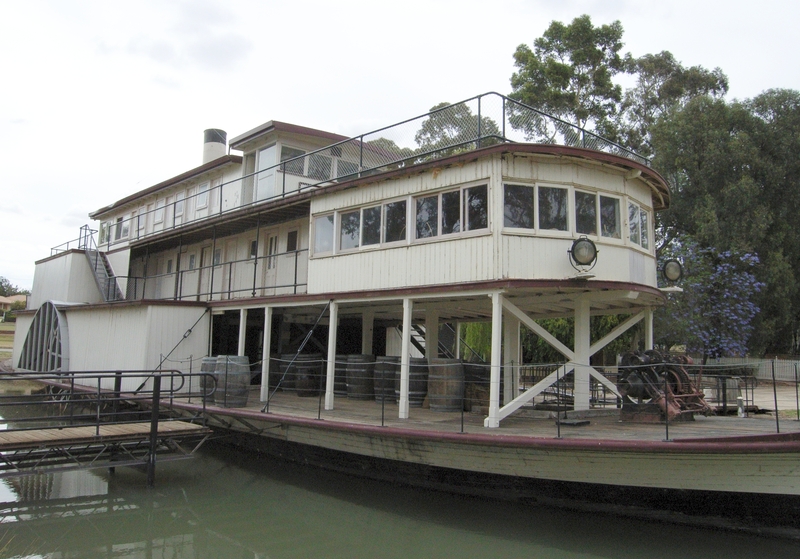


On this page:
Statement of Significance
What is significant?
The Paddle Steamer Gem was launched in Moama, NSW on 17 June 1876. The vessel is of composite build: red gum planking over iron frames and was built for the Echuca shipowner Elliot Randell by the firm of Air & Westergaard. Gem was originally fitted with a 40 horsepower steam engine and wood fired boilers and carried freight and passengers, mainly in the lower reaches of the Murray below Mildura. In 1882 at Goolwa in South Australia the vessel was lengthened from 28 metres to 40 metres by inserting a section amidships at the same time having its passenger accommodation increased and making it one of the largest steamers to have ever worked the Murray-Darling rivers. Gem passed through several ownerships including the Chaffey brothers at Mildura. Gem was able to keep trading right up until the end of the steam boat era on the Murray in the early 1950s. The vessel, minus its steam engine which had been scrapped then served as a floating residence and boarding house at Mildura until 1962 when it was purchased by the Borough of Swan Hill for use as a floating art gallery and focal point of Australia's first outdoor folk museum. The impetus for this came from Eric Westbrook, the director of the National Gallery of Victoria. The engineless Gem was towed to Swan Hill where it has floated in its own pool since 1963 serving for most of that time as an art gallery and restaurant. In recent years it has been undergoing a complete refit which has involved the removal of all the art gallery and restaurant fittings.
How is it significant?
The Paddle Steamer Gem is of historical and scientific (technological) significance to the State of Victoria.
Why is it significant?
The Paddle Steamer Gem is historically important as a rare survivor of the steam boat era of trading along the Murray-Darling. This nationally significant river trade was vitally important in the economic development of Victoria, New South Wales and South Australia. Gem, which had a long and active career, is one of only a handful of survivors to remain in Victoria. Gem is also significant for its role as the focal point of the Swan Hill Pioneer Settlement, the earliest example of its type in Australia.
The Paddle Steamer Gem is scientifically (technologically) important as an example of an iron framed wooden planked vessel designed for river use. Although unfortunately missing its original steam engine and despite several refits, Gem nonetheless retains much of its early fabric which can give insights into nineteenth century river boat building techniques.
The Paddle Steamer Gem was launched in Moama, NSW on 17 June 1876. The vessel is of composite build: red gum planking over iron frames and was built for the Echuca shipowner Elliot Randell by the firm of Air & Westergaard. Gem was originally fitted with a 40 horsepower steam engine and wood fired boilers and carried freight and passengers, mainly in the lower reaches of the Murray below Mildura. In 1882 at Goolwa in South Australia the vessel was lengthened from 28 metres to 40 metres by inserting a section amidships at the same time having its passenger accommodation increased and making it one of the largest steamers to have ever worked the Murray-Darling rivers. Gem passed through several ownerships including the Chaffey brothers at Mildura. Gem was able to keep trading right up until the end of the steam boat era on the Murray in the early 1950s. The vessel, minus its steam engine which had been scrapped then served as a floating residence and boarding house at Mildura until 1962 when it was purchased by the Borough of Swan Hill for use as a floating art gallery and focal point of Australia's first outdoor folk museum. The impetus for this came from Eric Westbrook, the director of the National Gallery of Victoria. The engineless Gem was towed to Swan Hill where it has floated in its own pool since 1963 serving for most of that time as an art gallery and restaurant. In recent years it has been undergoing a complete refit which has involved the removal of all the art gallery and restaurant fittings.
How is it significant?
The Paddle Steamer Gem is of historical and scientific (technological) significance to the State of Victoria.
Why is it significant?
The Paddle Steamer Gem is historically important as a rare survivor of the steam boat era of trading along the Murray-Darling. This nationally significant river trade was vitally important in the economic development of Victoria, New South Wales and South Australia. Gem, which had a long and active career, is one of only a handful of survivors to remain in Victoria. Gem is also significant for its role as the focal point of the Swan Hill Pioneer Settlement, the earliest example of its type in Australia.
The Paddle Steamer Gem is scientifically (technologically) important as an example of an iron framed wooden planked vessel designed for river use. Although unfortunately missing its original steam engine and despite several refits, Gem nonetheless retains much of its early fabric which can give insights into nineteenth century river boat building techniques.
Show more
Show less
-
-
PADDLE STEAMER GEM - Permit Exemptions
General Exemptions:General exemptions apply to all places and objects included in the Victorian Heritage Register (VHR). General exemptions have been designed to allow everyday activities, maintenance and changes to your property, which don’t harm its cultural heritage significance, to proceed without the need to obtain approvals under the Heritage Act 2017.Places of worship: In some circumstances, you can alter a place of worship to accommodate religious practices without a permit, but you must notify the Executive Director of Heritage Victoria before you start the works or activities at least 20 business days before the works or activities are to commence.Subdivision/consolidation: Permit exemptions exist for some subdivisions and consolidations. If the subdivision or consolidation is in accordance with a planning permit granted under Part 4 of the Planning and Environment Act 1987 and the application for the planning permit was referred to the Executive Director of Heritage Victoria as a determining referral authority, a permit is not required.Specific exemptions may also apply to your registered place or object. If applicable, these are listed below. Specific exemptions are tailored to the conservation and management needs of an individual registered place or object and set out works and activities that are exempt from the requirements of a permit. Specific exemptions prevail if they conflict with general exemptions. Find out more about heritage permit exemptions here.Specific Exemptions:General Conditions:
1. All exempted alterations are to be planned and carried out in a manner which prevents damage to the fabric of the registered place or object.
2. Should it become apparent during further inspection or the carrying out of alterations that original or previously hidden or inaccessible details of the place or object are revealed which relate to the significance of the place or object, then the exemption covering such alteration shall cease and the Executive Director shall be notified as soon as possible.
3. If there is a conservation policy and plan approved by the Executive Director, all works shall be in accordance with it.
4. Nothing in this declaration prevents the Executive Director from amending or rescinding all or any of the permit exemptions.
5. Nothing in this declaration exempts owners or their agents from the responsibility to seek relevant planning or building permits from the responsible authority where applicable.
Exterior
* Minor repairs and maintenance which replace like with like.
* Removal of extraneous items such as air conditioners, pipe work, ducting, wiring, antennae, aerials etc, and making good.
* Painting of previously painted surfaces provided that preparation or
painting does not remove evidence of the original paint or other decorative scheme.
Interior
* Removal of restaurant fittings and making good.
* Painting of previously painted walls and ceilings provided that preparation or painting does not remove evidence of the original paint or other decorative scheme.
* Removal of paint from originally unpainted or oiled joinery, doors,
architraves, skirtings and decorative strapping.
* Installation, removal or replacement of carpets and/or flexible floor
coverings.
* Installation, removal or replacement of curtain track, rods, blinds and other window dressings.
* Installation, removal or replacement of hooks, nails and other devices for the hanging of mirrors, paintings and other wall mounted artworks.
* Installation, removal or replacement of electrical wiring provided that all new wiring is fully concealed and any original light switches, pull cords, push buttons or power outlets are retained in-situ
* Installation, removal or replacement of smoke detectors.
-
-
-
-
-
SWAN HILL PIONEER SETTLEMENT
 Victorian Heritage Register H2409
Victorian Heritage Register H2409 -
Houses
 National Trust
National Trust -
Former Presbyterian Church
 National Trust
National Trust
-
177 Fenwick Street
 Yarra City
Yarra City -
19 Cambridge Street
 Yarra City
Yarra City -
2 Derby Street
 Yarra City
Yarra City
-






